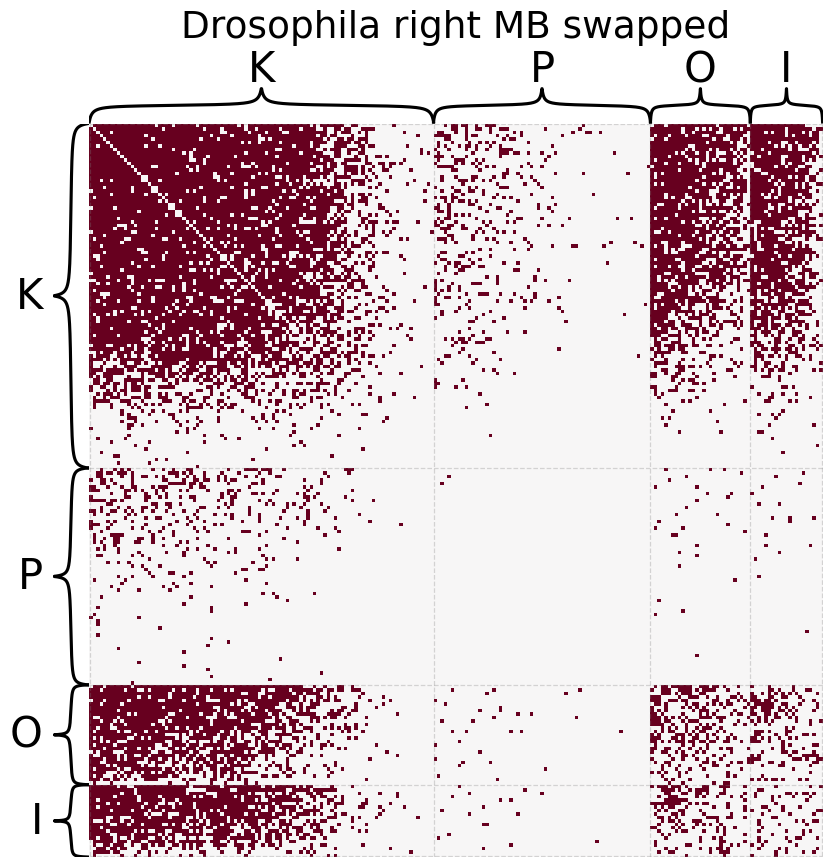Degree Preserving Edge Swaps¶
[1]:
from graspologic.datasets import load_drosophila_right
from graspologic.models import EdgeSwapper
from graspologic.plot import heatmap
from graspologic.utils import binarize, symmetrize
import networkx as nx
from scipy.sparse import csr_array
/home/runner/work/graspologic/graspologic/.venv/lib/python3.10/site-packages/tqdm/auto.py:21: TqdmWarning: IProgress not found. Please update jupyter and ipywidgets. See https://ipywidgets.readthedocs.io/en/stable/user_install.html
from .autonotebook import tqdm as notebook_tqdm
EdgeSwapper is a class that performs degree preserving edge swaps on networks. The distributions of graphs with a fixed degree sequence are known as configuration models, and these have extensive application for analyzing network datasets. The current implementation works on simple graphs (unewighted, no loops) that are of type np.ndarray or csr_array.
Now let us run dpes on these graphs and ensure that they have the same degree sequence
To begin, we’ll look at an example network, the Drosophila melanogaster larva right mushroom body connectome from Eichler et al. 2017.
Note: here we make the network undirected and unweighted for compatibility with the current implementation.
[2]:
#load the data
adj, labels = load_drosophila_right(return_labels=True)
adj = symmetrize(adj)
adj = binarize(adj)
_ = heatmap(adj,
inner_hier_labels=labels,
title='Drosophila right MB',
font_scale=1.5,
sort_nodes=True,
cbar=False)

Now, we’ll use EdgeSwapper to perform 10,000 random degree-preserving edge swaps - this will dramatically change the structure of the network but keep the degree of each node the same.
[3]:
swapper = EdgeSwapper(adj, seed=8888)
swapped_adj, _ = swapper.swap_edges(n_swaps=10000)
_ = heatmap(swapped_adj,
title='Drosophila right MB swapped',
font_scale=1.5,
sort_nodes=True,
inner_hier_labels=labels,
cbar=False)

We can see how the structure of the network above has changed: for example, there are now many edges among “I” (input) neurons when there were none before.
We can verify that the degree of each node in the network has been preserved:
[4]:
g = nx.from_numpy_array(adj)
swapped_g = nx.from_numpy_array(swapped_adj)
print(list(g.degree()) == list(swapped_g.degree()))
True
EdgeSwapper also works with csr_array adjacency representations.
[5]:
swapper = EdgeSwapper(csr_array(adj), seed=8888)
swapped_adj, _ = swapper.swap_edges(n_swaps=1000)
g = nx.from_numpy_array(adj)
swapped_g = nx.from_numpy_array(swapped_adj)
print(list(g.degree()) == list(swapped_g.degree()))
True
Often, degree-preserving edge swaps are used to sample a series of networks which resemble the original network in degree, but are otherwise random. This distribution of networks (sometimes called a configuration model) can be used to compare properties of the original network to this null distribution in order to evaluate whether some property is more or less prevalent in a given network than would be expected by chance. However, it is important to know that in practice, it can be difficult to tell how many edge swaps to perform to find a new network which is independent from the one you started with.